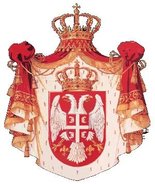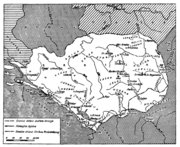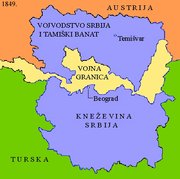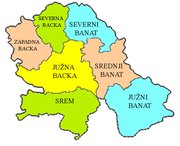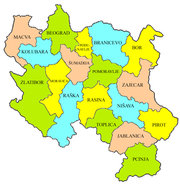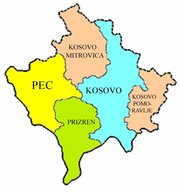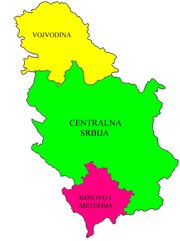Serbia
|
|
| |||||
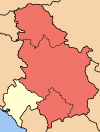
| Template:Serbia and Montenegro 2 | ||||
| Official language | SerbianTemplate:Footnote | ||||
| Capital | Belgrade | ||||
| Area – Total – % water | 88,361 km² n/a | ||||
| Population – Total (2002) (without Kosovo) – Density | 7.498.001 126.83/km² | ||||
| Ethnic groups (including Kosovo) | Serbs: 66% Albanians:17% Hungarians: 3.5% Bosniaks Roma Others | ||||
| President | Boris Tadić | ||||
| Prime Minister | Vojislav Koštunica | ||||
| Anthem | Bože Pravde | ||||
| Time zone | UTC +1 | ||||
| Currency | Serbian dinar (CSD)Also Euro (EUR) in Kosovo | ||||
| Internet TLD | .yu still used (.cs reserved) | ||||
| Airline carrier | Jat Airways | ||||
The Republic of Serbia (in Serbian Република Србија or Republika Srbija) is a republic in south-eastern Europe which is united with Montenegro in a loose commonwealth known as the State Union of Serbia and Montenegro.
The roots of the Serbian state reach back to the first half of the 9th century. The Kingdom of Serbia was established in the 11th century, and in the 13th century it eventually became the Serbian Empire. After 1918, Serbia was a founder member of Yugoslavia in its various forms (the Kingdom of Yugoslavia, the Socialist Federal Republic of Yugoslavia, and the Federal Republic of Yugoslavia).
| Contents [hide] |
Culture
See also:
- Serbian language
- Serbian Literature
- Serbian Law
- Music of Serbia
- Serbian Cuisine
- painting
- sculpture
- Serbian Contemporary Art
- photography
- folklore and traditional music
- classical and contemporary music
- cinematography
- architecture
- Famous Serbian people
Serbian literature
Early Serbian literature was dominated by folk songs and epics passed orally from generation to generation. Historic events, such as the "Battle of Kosovo" (Бој на Косову / Boj na Kosovu) in the 14th century play a major role in the development of the Serbian epics.
By being one of the first countries to win independence from the Ottoman Empire, the Serbian independence movement sparked the first works of modern Serbian literature. Most notably Petar II Petrović Njegoš and his "Mountain Wrath" (Горски Вијенац / Gorski Vijenac) of 1847, represent a cornerstome of the Serbian epic, which was based on the rythms of the folk songs. Furthermore Vuk Stefanović Karadžić, a close friend of J. W. von Goethe, became the first person to collect folk songs and epics and to publish them in a book. Stefanović Karadžić is regarded as the permier Serbian philologist, who to gether with Daničić played a major role in reforming the modern Serbian language, though in recent times his work has been widely criticized for destroying the ethos of the Serbian language.
In the 20th century, Serbian literature flourished and a myriad of young and talented writers appeared. Ivo Andrić published The Bridge on the Drina (На Дрини Ћуприја / Na Drini Ćuprija) in 1945, for which he received the Nobel Prize for Literature in 1961. His influence on the literature of the region is enormous, though he is becoming increasingly unpopular in Croatia and among Bosnian Muslims. Since Andrić, Danilo Kiš is regarded as one of the most notable Serbian authors, alongside writers such as Meša Selimović, David Albahari, Milorad Pavić, Dobrica Ćosić and many others.
History
Main article: History of Serbia
See also: List of Serbian monarchs, History of Yugoslavia, History of Serbia and Montenegro
Medieval Serbia, 7th – 14th century
The Serbs entered their present territory early in the 7th century, settling in six distinct tribal delimitations:
- Rascia / Raška,
- Zachumlie / Zahumlje,
- Trebounia / Travunija,
- Duklja / Zeta,
- Bosnia / Bosna and
- Pagania / Paganija.
The first recorded Serb princes were Vlastimir, Viseslav, Radoslav and Prosigoj. By that time, the country had entirely accepted Christianity. In Zeta, today's Montenegro, Mihailo was crowned by the Pope, then his son Bodin reclaimed the throne, but it lasted for a few years (the first mention of this is a century later, in the 10th century. The rulers kept changing and the country accepted supreme protection from the Byzantine Empire rather than from hostile Bulgaria. Serbia was freed from the Byzantine Empire a century later.
The first Serb-organized state emerged under Časlav Klonimirović in the mid-10th century in Rascia. The first half of the 11th century saw the rise of the Vojislavljević family in Zeta. Marked by disintegration and crises it lasted until the end of 12th century. After a struggle for the throne with his brothers, Stefan Nemanja, the founder of the Nemanjić dynasty, rose to power in 1166 and started renewing the Serbian state in the Raska region. Sometimes with the sponsorship of Byzantium, and sometimes opposing it, the veliki zupan (a title equivalent to the rank of prince) Stefan Nemanja expanded his state seizing territories east and south, and newly annexed the littoral and the Zeta region. Along with his governmental efforts, the veliki zupan dedicated much care to the construction of monasteries. His endowments include the Djurdjevi Stupovi Monastery and the Studenica Monastery in the Raska region, and the Hilandar Monastery on Mount Athos. Nemanjići led Serbia to a golden age which produced a powerful state with its apogee under Tsar Stefan Dušan in the mid-14th century, before finally succumbing to the Ottoman Empire (with Zeta, the last bastion, finally falling in 1499).
Stefan Nemanja was succeeded by his middle son Stefan II, whilst his first-born Vukan was given the rule of the Zeta region (present-day Montenegro). Stefan Nemanja's youngest son Rastko became a monk and took the name of Sava, turning all his efforts to spreading religiousness among his people. Since the Curia already had ambitions to spread its influence to the Balkans as well, Stefan II (Prvovencani) used these propitious circumstances to obtain his crown from the Pope thus becoming the first Serbian king in 1217. In Byzantium, his brother Sava managed to secure the autocephalous status for the Serbian Church and became the first Serbian archbishop in 1219. Thus the Serbs acquired both forms of independence: temporal and religious.
The next generation of Serbian rulers - the sons of Stefan Prvovencani - Radoslav, Vladislav and Uros I, marked a period of stagnation of the state structure. All three kings were more or less dependent on some of the neighboring states - Byzantium, Bulgaria or Hungary. The ties with the Hungarians had a decisive role in the fact that Uros I was succeeded by his son Dragutin whose wife was a Hungarian princess. Later on, when Dragutin abdicated in favor of his younger brother Milutin (in 1282), the Hungarian king Ladislaus IV gave him lands in northeastern Bosnia, the regions of Srem, Slavonia and Macva, and the city of Belgrade, whilst he managed to conquer and annex lands in northeastern Serbia. His new state was named Kingdom of Srem, and northern border of the state crossed not only the Sava river, but also the Danube. Thus, some of these territories became part of the Serbian state for the first time. After Dragutin died (in 1316), new ruler of the Kingdom of Srem became his son, king Vladislav II, which ruled this state until 1325.
Under the rule of Dragutin's younger brother — Milutin, Serbia grew stronger in spite of the fact that occasionally it had to fight wars on three different fronts. King Milutin was an apt diplomat much inclined to the use of a customary mediæval diplomatic expedients — dynastic marriages. He was married five times, with Hungarian, Bulgarian and Byzantine princesses. He is also famous for building churches, some of which are the brightest examples of mediæval Serbian architecture: the Gracanica Monastery in Kosovo[1] (http://www.kosovo.com/egracanica.html), the Cathedral in Hilandar Monastery on Mount Athos, the St Archangel Church in Jerusalem etc. Because of his endowments, King Milutin has been proclaimed a saint, in spite of his tumultuous life. He was succeeded on the throne by his son Stefan, later dubbed Stefan Decanski. Spreading the kingdom to the east by winning the town of Niš and the surrounding counties, and to the south by acquiring territories on Macedonia, Stefan Decanski was worthy of his father and built the Visoki Decani Monastery [2] (http://www.kosovo.com/edecani.html) in Metohija — the most monumental example of Serbian mediæval architecture — that earned him his nickname.
Dusanova_Srbija200.jpg
Mediæval Serbia, which enjoyed a high political, economic and cultural reputation in Mediæval Europe, reached its apex in the middle of the 14th century, during the rule of Tsar Stefan Dusan1331-1355. This is the period when the Dusanov Zakonik (Dusan's Code 1349) the greatest juridical achievement of mediæval Serbia, unique among the European feudal states of the period. St Sava's Nomocanon, Dusan's Code, frescoes and the architecture of the mediæval monasteries adorning Serbian lands are eternal civilizational monuments of the Serbian people. Tzar Stefan Dusan doubled the size of his kingdom seizing territories to the south, southeast and east at the expense of Byzantium. He was succeeded by his son Uros called the Weak, a term that might also apply to the state of the kingdom slowly sliding into feudal anarchy. This is a period marked by the rise of a new threat: the Ottoman Turk sultanate gradually spreading from Asia to Europe and conquering Byzantium first, and then the other Balkans states.
Turkish conquest
Having defeated the Serbian army in two crucial battles: on the banks of the river Marica in 1371 — where the forces of noblemen from Macedonia were defeated, and on Kosovo Polje (Kosovo Field) in 1389, where the vassal troops commanded by Prince Lazar — the strongest regional ruler in Serbia at the time — suffered a catastrophic defeat. The Battle of Kosovo defined the fate of Serbia, because after it no force capable of standing up to the Turks existed. This was an unstable period marked by the rule of Prince Lazar's son — despot Stefan Lazarevic — a true European-style knight a military leader and even poet, and his cousin Đurađ Branković, who moved the capital north — to the newly built fortified town of Smederevo. The Turks continued their conquest until they finally seized the entire Serbian territory in 1459 when Smederevo fell into their hands. Serbia was ruled by the Ottoman Empire for almost five centuries. The Turks persecuted the Serbian aristocracy, determined to physically exterminate the social elite. Since the Ottoman Empire was an Islamic theocratic state, Christian Serbs lived as virtual bond servants — abused, humiliated and exploited. Consequently they gradually abandoned the developed and urban centers where mining, crafts and trade was practiced and withdrew to hostile mountains living on cattle breeding and modest farming.
In the battle of Mohac on august 29 1526, Ottoman Turkey destroyed the army of Hungarian-Czech king Louis Jagellion, who was killed on the battlefield. After this battle Hungary ceased to be independent state and became a part of the Ottoman Empire. Soon after the Battle of Mohács, leader of Serbian mercenaries in Hungary, Jovan Nenad established his rule in Backa, northern Banat and a small part of Srem (These 3 regions are now parts of Vojvodina). He created an ephemeral independent state, with city Subotica as its capital. At the pitch of his power, Jovan Nenad crowned himself in Subotica for Serb emperor. Taking advantage of the extremely confused military and political situation, the Hungarian noblemen from the region joined forces against him and defeated the Serbian troops in the summer of 1527. Emperor Jovan Nenad was assassinated and his state collapsed.
European powers, and Austria in particular, fought many wars against Turkey, relying on the help of the Serbs that lived under Ottoman rule. During the Austrian–Turkish War (1593–1606). in 1594, the Serbs staged an uprising in Banat — the Pannonian part of Turkey, and sultan Murad III retaliated by burning the remains of St Sava — the most sacred thing for all Serbs, honored even by Muslims of Serbian origin. Serbs created another center of resistance in Hercegovina but when peace was signed by Turkey and Austria they abandoned to Turkish vengeance. This sequence of events became usual in the centuries that followed.
During the Great War (1683–90) between Turkey and the Holy League — created with the sponsorship of the Pope and including Austria, Poland and Venice — these three powers incited the Serbs to rebel against the Turkish authorities and soon uprisings and guerrilla spread throughout the western Balkans: from Montenegro and the Dalmatian coast to the Danube basin and Ancient Serbia (Macedonia, Raska, Kosovo and Metohija). However, when the Austrians started to pull out of Serbia, they invited the Serbian people to come north with them to the Austrian territories. Having to choose between Turkish vengeance and living in a Christian state, Serbs massively abandoned their homesteads and headed north lead by their patriarch Arsenije Carnojevic. Many areas in southern Balkans were de-populated in the process, and the Turks used the opportunity to Islamize Raska, Kosovo and Metohija and to a certain extent Macedonia. A process whose effects are still visible today started.
Another important episode in Serbian history took place in 1716–18, when the Serbian ethnic territories ranging from Dalmatia, and Bosnia and Herzegovina to Belgrade and the Danube basin newly became the battleground for a new Austria-Turkish war launched by Prince Eugene of Savoy. The Serbs sided once again with Austria. After a peace treaty was signed in Pozarevac, Turkey lost all its possessions in the Danube basin, as well as northern Serbia and northern Bosnia, parts of Dalmatia and the Peloponnesus.
The last Austrian-Turkish war was the so called Dubica War (1788–91), when the Austrians newly urged the Christians in Bosnia to rebel. No wars were fought afterwards until the 20th century that marked the fall of both mighty empires.
Modern Serbia
Grbsr.gif
Serbia gained its autonomy from the Ottoman Empire in two uprisings in 1804 and 1815, although Turkish troops continued to garrison the capital, Belgrade, until 1867. The Turkish Empire was already faced with a deep internal crisis without any hope of recuperating. This had a particularly hard effect on the Christian nations living under its rule. The Serbs launched not only a national revolution but a social one as well and gradually Serbia started to catch up with the European states with the introduction of the bourgeois society values. Resulting from the uprisings and subsequent wars against the Ottoman Empire, the independent Principality of Serbia was formed and granted international recognition in 1878. Serbia was a principality or kneževina (knjaževina), between 1817 and 1882, and a kingdom between 1882 and 1918, during which time the internal politics revolved largely around dynastic rivalry between the Obrenović and Karađorđević families.
This period was marked by the alternation of two dynasties descending from Djordje Petrović — Karadjordje, leader of the First Serbian Uprising and Miloš Obrenović, leader of the Second Serbian Uprising. Further development of Serbia was characterized by general progress in economy, culture and arts, primarily due to a wise state policy of sending young people to European capitals to get an education. They all brought back a new spirit and a new system of values. One of the external manifestations of the transformation that the former Turkish province was going through was the proclamation of the Kingdom of Serbia in 1882.
Between 1849 and 1860 there was an Austrian crown land known as Dukedom (Vojvodina) of Serbia and Tamis Banat. This region is still known as Vojvodina.
In the second half of 19th century, Serbia was integrated into the constellation of European states and the first political parties were founded thus giving new momentum to political life. The coup d'état in 1903, bringing Karadjordje's grandson to the throne with the title of King Petar I opened the way for parliamentary democracy in Serbia. Having received a European education, this liberal king translated "On Freedom" by John Stuart Mill and gave his country a democratic constitution. It initiated a period of parliamentary government and political freedom interrupted by the outbreak of the liberation wars. The Balkan wars 1912–13, terminated the Turkish domination in the Balkans. Turkey was pushed back towards the Bosporus, and national Balkan states were created in the territories it withdrew from.
Serbia in World War I
The June 28, 1914 assassination of Austrian Crown Prince Franz Ferdinand in the Bosnian capital Sarajevo, served as a pretext for the Austrian attack on Serbia that marked the beginning of World War I, despite Serbia's acceptance (on July 25) of nearly all of Austria-Hungary's demands. The Serbian Army bravely defended its country and won several major victories, but it was finally overpowered by the joint forces of Germany, Austria-Hungary and Bulgaria, and had to withdraw from the national territory marching across the Albanian mountain ranges to the Adriatic Sea. Having recuperated on Corfu the Serbian Army returned to combat on the Thessaloniki front together with other Entente forces comprising France, the United Kingdom, Russia, Italy and the United States. In World War I, Serbia had 1,264,000 casualties — 28% of its 4½m population, which also represented 58% of its male population — a loss from which it never fully recovered. This enormous sacrifice was the contribution Serbia gave to the Allied victory and the remodeling of Europe and of the World after World War I.
The Kingdom of Yugoslavia
With the end of World War I and the collapse of both the Austro-Hungarian and Ottoman Empires the conditions were met for proclaiming the Kingdom of Serbs, Croats and Slovenes in December of 1918. The Yugoslav ideal had long been cultivated by the intellectual circles of the three nations that gave the name to the country, but the international constellation of political forces and interests did not permit its implementation until then. However, after the war, idealist intellectuals gave way to politicians, and the most influential Croatian politicians opposed the new state right from the start.
The Croatian Peasant Party (HSS) headed by Stjepan Radić, and then by Vlatko Macek slowly grew to become a massive party endorsing Croatian national interests. According to its leaders the Yugoslav state did not provide a satisfactory solution to the Croatian national question. They chose to conduct their political battle by systematically obstructing state institutions and making political coalitions to undermine the state unity, thus extorting certain concessions. Each political or economic issue was used as a pretext for raising the so-called "unsettled Croatian question".
Trying to match this challenge and prevent any further weakening of the country, King Alexander I banned national political parties in 1929, assumed executive power, and renamed the country Yugoslavia. He hoped to curb separatist tendencies and mitigate nationalist passions. However the balance of power changed in international relations: in Italy and Germany, Fascists and Nazis rose to power, and Stalin became the absolute ruler in the Soviet Union. None of these three states favored the policy pursued by Alexander I. The first two wanted to revise the international treaties signed after World War I, and the Soviets were determined to regain their positions in Europe and pursue a more active international policy. Yugoslavia was an obstacle for these plans, and King Aleksandar I was the pillar of the Yugoslav policy.
During an official visit to France in 1934, the king was assassinated in Marseilles by a member of the Internal Macedonian Revolutionary Organization — an extreme nationalist organization in Bulgaria that had plans to annex territories along the eastern and southern Yugoslav border — with the cooperation of the Ustashi — a Croatian fascist separatist organization. The international political scene in the late 1930s was marked by growing intolerance between the principal figures, by the aggressive attitude of the totalitarian regimes, and by the certainty that the order set up after World War I was losing its strongholds and its sponsors were losing their strength. Supported and pressured by Fascist Italy and Nazi Germany, Croatian leader Vlatko Macek and his party managed to extort the creation of the Croatian banovina (administrative province) in 1939. The agreement specified that Croatia was to remain part of Yugoslavia, but it was hurriedly building an independent political identity in international relations.
Serbia in World War II
At the beginning of the 1940s, Yugoslavia found itself surrounded by hostile countries. Except for Greece, all other neighboring countries had signed agreements with either Germany or Italy. Hitler was strongly pressuring Yugoslavia to join the Axis powers. The government was even prepared to reach a compromise with him, but the spirit in the country was completely different. Public demonstrations against Nazism prompted a brutal reaction. The Luftwaffe bombed Belgrade and other major cities and in April 1941, the Axis powers occupied Yugoslavia and disintegrated it. The western parts of the country together with Bosnia and Herzegovina were turned into a Nazi puppet state called the Independent State of Croatia (NDH) and ruled by the Ustashe. Serbia was occupied by German troops, but the northern territories were annexed by Hungary, and eastern and southern territories to Bulgaria. Kosovo and Metohija were mostly annexed by Albania which was under the sponsorship of fascist Italy. Montenegro also lost territories to Albania and was then occupied by Italian troops. Slovenia was divided between Germany and Italy that also seized the islands in the Adriatic.
Following the Nazi example, the Independent State of Croatia established extermination camps and perpetrated an atrocious genocide killing over 750,000 Serbs, Jews and Gypsies. This holocaust set the historical and political backdrop for the Yugoslav wars that broke out fifty years later in Croatia and Bosnia–Herzegovina and that accompanied the break-up of Yugoslavia in 1991–92.
The ruthless attitude of the German occupation forces and the genocidal policy of the Croatian Ustasha regime generated a strong Serbian Resistance. The Serbs stood up against the Croatian genocidal government and the Nazi disintegration of Yugoslavia. Many joined the Partisan forces (National Liberation Army headed by Josib Broz Tito) in the liberation war and thus helped the Allied victory. By the end of 1944, with the help of the Red Army the Partisans liberated Serbia and by May 1945 the remaining Yugoslav territories, meeting up with the Allied forces in Hungary, Austria and Italy. Serbia and Yugoslavia were among the countries that had the greatest losses in the war: 1,700,000 (10.8% of the population) people were killed and national damages were estimated at 9.1 billion dollars according to the prices of that period.
Serbia in the Socialist Federal Republic of Yugoslavia
While the war was still raging, in 1943, a revolutionary change of the social and state system was proclaimed with the abolition of monarchy in favor of the republic. Josip Broz Tito became the first president of the new — socialist — Yugoslavia. Once a predominantly agricultural country, Yugoslavia was transformed into a mid-range industrial country, and acquired an international political reputation by supporting the de-colonization process and by assuming a leading role in the non-aligned movement. Socialist Yugoslavia was established as a federal state comprising six republics: Serbia, Croatia, Slovenia, Bosnia–Herzegovina, Macedonia and Montenegro and two autonomous regions within Serbia — Vojvodina and Kosovo and Metohija. The Serbs were both the most numerous and the most widely distributed of the Yugoslav peoples.
The 1974 constitution produced a significantly less centralized federation, increasing the autonomy of Yugoslavia's republics as well as the autonomous provinces of Serbia.
When Tito died in 1980, he was succeeded by a rotating presidency that led to a further weakening of ties between the republics. During the 1980s the republics pursued significantly different economic policies, with Slovenia and Croatia allowing significant market-based reforms, while Serbia kept to its existing program of state ownership. This, too, was a cause of tension between north and south, as Slovenia in particular experienced a period of strong growth.
The break-up of Yugoslavia
Yugoslavia broke up in the early 1990s after the secession of Slovenia and Croatia. The Yugoslav wars that followed were initially fought in the name of forcibly keeping Yugoslavia united. They soon became overtly nationalist in character, with a clash between the nationalist ideologies personified by Serbian President Slobodan Milošević and Croatian President Franjo Tudjman.
On April 281992 Serbia and Montenegro proclaimed themselves to be the Federal Republic of Yugoslavia. Their claim to be the legal sucessor state to the Yugoslav federation did not gain wide international acceptance.
The Serb-Croat conflict was greatly complicated in Bosnia by the presence of the large Muslim (Bosniak) population, which caused it to develop into a three-way conflict that was by far the bloodiest of the Yugoslav wars.
The Yugoslav wars in the west were ended by the military withdrawal in Slovenia and the defeat of Serbian rebels in Croatia, and the signing of the Dayton Agreement in 1995 for Bosnia following NATO airstrikes against the Bosnian Serb army and its warning to Muslim-Croat forces that a rout of Bosnian Serbs would not be tolerated. The Dayton agreement foresaw a unitary Bosnian state consisting of ethnic enclaves (See Republika Srpska).
In 1999, reported Serbian action in Kosovo led to NATO aerial bombardment (See Kosovo War). The war stopped only after Milošević agreed to the retreat of the army and police from Kosovo. The province is now governed by the UN.
Slobodan Milošević remained in power after the Kosovo conflict. He claimed victory in the September 242000 elections, which the opposition claimed had been rigged in his favor. Opposition candidate Vojislav Kostunica declared himself the rightful winner, and half a million protesters rallied in front of the parliament in Belgrade on October 5 to demand Milošević stand down. After demonstrations and fighting with police still loyal to Milošević, he was overthrown and later arrested, and Kostunica took power as President. Following parliamentary elections in January 2001, Zoran Djindjic became Prime Minister. After two years of struggle, trying to reform a destroyed country and fighting with people who were afraid of the changes that the new Prime Minister applied, Djindjic was assassinated in Belgrade on March 122003 by assailants believed to be connected with organized crime.
Immediately after the assassination, the government declared "war" on the mafia. Zoran Zivković led the government until a new election was held in December 2003. After almost three months of negotiations, Vojislav Kostunica formed the new government in March 2004. Three months later, Boris Tadić, successor of Zoran Djindjic as President of the Democratic Party, became the new President of Serbia.
In 2003 the name Yugoslavia was finally retired, as the two states agreed to a looser union, to be known as Serbia and Montenegro.
Geography
Main article: Geography of Serbia
Serbia is located in the Balkans (an historically and geographically distinct region of southeastern Europe) and in the Pannonian Plain (an region of central Europe). It shares borders with Albania, Montenegro, Bosnia-Herzegovina, Bulgaria, Croatia, Hungary, the Former Yugoslav Republic of Macedonia, and Romania. Serbia is landlocked, although access to the Adriatic is available through neighbouring Montenegro, and the Danube River provides shipping access to inland Europe and the Black Sea.
Serbia's terrain ranges from the rich, fertile plains of the northern Vojvodina region, limestone ranges and basins in the east, and, in the southeast, ancient mountains and hills. The north is dominated by the Danube River. A tributary, the Morava River flows through the more mountainous southern regions.
The Serbian climate varies between a continental climate in the north, with cold winters, and hot, humid summers with well distributed rainfall patterns, and a more Adriatic climate in the south with hot, dry summers and autumns and relatively cold winters with heavy snowfall inland.
See also: List of cities in Serbia and Montenegro
Mountains
Districts
Main article: Districts of Serbia
A district is called Округ / Okrug in Serbian. The Republic of Serbia is divided into 29 districts and the city of Belgrade. Each okrug is made up of several Општина / Opština (municipalities), the closest equivalent of which would be an English borough, with the difference that all of Serbia is divided into opština, not just urban areas.
List of districts:
- Bor
- Braničevo
- Jablanica
- Kolubara
- Mačva
- Moravica
- Nišava
- Pčinja
- Peć
- Pirot
- Podunavlje
- Pomoravlje
- Prizren
- Raška
- Rasina
- Šumadija
- Toplica
- Zaječar
- Zlatibor
- North Bačka
- South Bačka
- West Bačka
- North Banat
- Central Banat
- South Banat
- Srem
- Kosovo
- Kosovo-Pomoravlje
- Kosovska Mitrovica
- Belgrade
Administrative subdivisions
Serbia is made up of 108 municipalities. It has two autonomous provinces: Kosovo and Metohija in the south (with 30 municipalities), which is presently under the administration of the United Nations, and Vojvodina in the north (with 54 municipalities).
The part of Serbia that is neither in Kosovo nor in Vojvodina is called Central Serbia. Central Serbia is not an administrative division (unlike the two autonomous provinces), and it has no regional government of its own. In English this region is often called "Serbia proper" to denote "the part of the Republic of Serbia not including the provinces of Vojvodina and Kosovo; the ethnic and political core of the Serbian state", as the Library of Congress puts it [3] (http://lcweb2.loc.gov/frd/cs/yugoslavia/yu_glos.html). This usage was apparently also employed in Serbo-Croatian during the Yugoslav era (in the form of "uža Srbija" literally: narrow Serbia). Its use in English is purely geographical without any particular political meaning being implied.
Some political parties in Serbia (notably Democratic Party of Serbia and Sumadija Coalition) propose creation of new administrative units of Serbia. According to these proposals, Serbia would be divided into 6 regions: Vojvodina (capital city: Novi Sad), Kosovo (capital city: Pristina), Sumadija (capital city: Kragujevac), Podunavlje (capital city: Nis), Podrinje (capital city: Uzice), and Belgrade City Region.
National parks
Serbia has five national parks and many national nature reserves.
Politics
Main article: Politics of Serbia
On 4 February 2003 the parliament of the Federal Republic of Yugoslavia agreed to a weaker form of cooperation between Serbia and Montenegro within a commonwealth called Serbia and Montenegro.
After the fall of Slobodan Milošević on 5 October 2000, the country was governed by the Democratic Opposition of Serbia. When Milošević was arrested, the Democratic Party of Serbia (DSS) abandoned the coalition government. Nevertheless, in 2004 the DSS gathered enough support to form the new Government of Serbia, together with G17 Plus and coalition SPO-NS, and the support of the Socialist Party of Serbia. The Prime Minister of Serbia is Vojislav Kostunica, leader of the Democratic Party of Serbia.
The current President of Serbia is Boris Tadić, leader of the Democratic Party (DS). He was elected with 53% of the vote in the second round of the Serbian presidential election held on 27 June 2004, following several unsuccessful elections since 2002.
The current Prime Minister of the Government of Serbia, as of March 2004, is the former Yugoslav president, Vojislav Kostunica, who replaced Slobodan Milosevic as Yugoslav president in October of 2000.
Laws concerning the state union must be approved by the Parliament of Serbia and Montenegro, while bills concerning only Serbia are submitted to the National Assembly of Serbia.
Transportation
Main article: Transportation in Serbia and Montenegro
Serbia, and in particular the valley of the Morava, is often described as "the crossroads between East and West", which is one of the primary reasons for its turbulent history. The Morava valley route, which avoids mountainous regions, is by far the easiest way of travelling overland from continental Europe to Greece and Asia Minor.
European routes E65, E70, E75 and E80, as well as the E662, E761, E762, E763, E771, and E851 pass through the country. The E70 westwards from Belgrade and most of the E75 are modern highways of motorway / autobahn standard or close to that.
The Danube River, central Europe's connection to the Black Sea, flows through Serbia.
There are three international airports in Serbia: Belgrade, Priština, and the newly rebuilt Niš airport.
The national airline carrier is Jat Airways and the railway system is operated by Beovoz in Belgrade and by ZTP on the national level.
Demographics
Main article: Demographic history of Serbia
Serbia is populated mostly by Serbs. Significant minorities include Albanians, Hungarians, Muslims(Bosniaks), Roma, Croats, Slovaks, Bulgarians and Romanians. Serbia consists of three territories: the province of Kosovo and Metohia, the province of Vojvodina and "Serbia proper" (Serbian Cyrillic: Ужа Србија, Serbian Latin: Uža Srbija, English lit.: Narrower Serbia). Both provinces are extremely ethnically diverse which is a result of the division of the country between the Muslim Ottoman Empire and Catholic Austro-Hungarian Empire.
The southern province of Kosovo, once heart of the medieval Orthodox Christian Serbia, during the Ottoman reign became largely populated by different Muslim peoples, especially Albanians but also Turks, Egyptians and so on. Today Kosovo is a home to only about 150,000 Serbs, comparing to about 1.8 million Albanians and 200,000 others, as 100,000–250,000 Serbs left after the Kosovo War of 1999, 80,000 during the 1980s and more than 100,000 during World War II. At the same time as the Serbian population declined, the Albanian population grew exponentially, from about 300,000– 400,000 in the 1930s, to an estimated 1.8–2 million in 2000, due to a combination of factors, mainly massive illegal immigration from Albania and a high birth rate when compared to the Serbian population. For Albanians, Kosovo was an attractive place to emigrate to as it already had a substantial Albanian population, it neighboured Albania, it was easy to cross the mountainous border without being detected and the standard of living was much higher than in Albania, despite being much lower than in the rest of Yugoslavia. See also: Demographic history of Kosovo and Metohia.
The northern province of Vojvodina is the most developed part of the country in terms of economic strength, liberal values, quality of education and so on. Together with the Former Yugoslav republics of Slovenia, Croatia and Bosnia and Herzegovina, Vojvodina was part of the Austro-Hungarian Empire before the First World War. Vojvodina is probably the most ethnically diverse territory in Europe, excepting London, a fact which tends to surprise most people who only know of Serbia through the prism of the 1990s. More than 25 ethnic groups live in the province. According to the last completed census (2002), the province has a population of about 2 million, of which: Serbs 65%, Hungarians 14.3%, Slovaks 2.79%, Croats 2.78%, undeclared 2.71%, Yugoslavs 2.45%, Montenegrins 1.75%, Romanians 1.50%, Roma 1.43%, Bunjevci 0.97%, Ruthenians 0.77%, Macedonians 0.58%, regional affiliation 0.50%, Ukrainians 0.23%, others (Albanians, Slovenians, Germans, Poles etc). See also: Demographic history of Vojvodina
- Population statistics of Serbia (Estimate May 2005)
- Serbia (total) 9 396 411
- Vojvodina: 2 116 725
- Central Serbia: 5 479 686
- Kosovo: 1 800 000
- Main cities (over 100 000 inhabitants) - estimate May 2005
- Beograd (Belgrade): 1 586 382
- Novi Sad: 302 294
- Niš: 252 275
- Priština: 251 784
- Kragujevac: 176 682
- Subotica: 150 488
Economy
Main article: Economy of Serbia
Latest economy statistics:
- Gross Domestic Product
- Real GDP:$25.98 Billion (2004) - Predicted to grow by 5% in 2005
- Real GDP Per Capita: $2941 (May 2005)
- Real GDP growth rate: 7% (2004)
- Other statistics (in detail on economy page)
- Industrial production growth rate: 7.1% (2004)
- Unemployment rate: 18.50% (Q1 2005)
- Inflation: 13.7% (2004)
- Foreign debt: $12.97 Billion (49.9% of GDP)
- Direct foreign investment to date (2005): $900 Million
Holidays in Serbia
| Date | Name |
|---|---|
| January 1 | New Year's Day |
| January 7 | Orthodox Christmas |
| February 15 | Serbia National Day |
| April 27 | Constitution Day |
| April 29 * | Orthodox Good Friday |
| May 1 * | Orthodox Easter |
| May 2 * | Orthodox Easter Monday |
| May 1 | Labour Day |
| May 9 | Victory Day |
| June 28 | Martyr's Day in memory of Battle of Kosovo soldiers |
* Dates in 2005 only
Miscellaneous
- On August 17 2004 the National Assembly of Serbia adopted Bože Pravde as the country's anthem.
- In addition, the Obrenović royal coat of arms now replaces the Coat of Arms of Serbia adopted after World War II. It was first used in the 19th century. The arms are those of the royal Obrenović dynasty; they are used in two versions, the large (pictured) and small (just the central shield with eagle and crown surmounting). Use of these arms is 'recommended' which means that the coat of arms is not yet official. It will become so if adoption of the Obrenović arms is approved by more than 50% of the voters in a constitutional referendum.
- Asteroid 1564 Srbija is discovered by Milorad B. Protitch and named after Serbia.
External links
Government links
- Serbian Government (http://www.srbija.sr.gov.yu/?change_lang=en)
- National Assembly of Serbia (http://www.parlament.sr.gov.yu/content/eng/index.asp)
- The EU integration Office of Serbian Government (http://www.seio.sr.gov.yu/)
- People's Office of Serbian President (http://www.narodnakancelarija.srbija.yu/)
- National Bank of Serbia (http://www.nbs.yu/english/index.htm)
- RTS - Serbian Broadcasting Corporation (http://www.rts.co.yu/)
- Republic of Serbia Statistical Office (http://www.statserb.sr.gov.yu/)
- Institute for the Protection of Cultural Monuments of Serbia (http://www.heritage.org.yu/)
- The European movement in Serbia (http://www.emins.org/english/index.html/)
| Countries in Europe |
|---|
| Albania | Andorra | Austria | Azerbaijan1 | Belarus | Belgium | Bosnia and Herzegovina | Bulgaria | Croatia | Cyprus2 | Czech Republic | Denmark | Estonia | Finland | France | Germany | Greece | Hungary | Iceland | Ireland | Italy | Latvia | Liechtenstein | Lithuania | Luxembourg | Macedonia | Malta | Moldova | Monaco | Netherlands | Norway | Poland | Portugal | Romania | Russia1 | San Marino | Serbia and Montenegro | Slovakia | Slovenia | Spain | Sweden | Switzerland | Turkey1 | Ukraine | United Kingdom | Vatican City |
| Dependencies: Akrotiri and Dhekelia2 | Faroe Islands | Gibraltar | Guernsey | Jan Mayen | Jersey | Isle of Man | Svalbard |
| 1. Country partly in Asia. 2. Usually assigned to Asia geographically, but often considered European for cultural and historical reasons. |

| State Union Serbia and Montenegro | Missing image Srcoa.gif Flag of Serbia 
|
|
Republics: Serbia | Montenegro | ||
|
Autonomous provinces of Serbia: Kosovo and Metohija | Vojvodina | ||
| | Missing image Srcoa.gif Flag of Serbia |
|---|---|
|
North Bačka | South Bačka | West Bačka | North Banat | Central Banat | South Banat | Bor | Braničevo | Jablanica | Kolubara | Kosovo | Kosovo-Pomoravlje | Kosovska Mitrovica | Mačva | Moravica | Nišava | Pčinja | Peć | Pirot | Podunavlje | Pomoravlje | Prizren | Raška | Rasina | Srem | Šumadija | Toplica | Zaječar | Zlatibor | |
chr:ᏎᎸᏈᏯ cy:Serbia de:Serbien eo:Serbio es:Serbia et:Serbia fr:Serbie ko:세르비아 he:סרביה hr:Srbija id:Serbia it:Serbia la:Serbia lt:Serbija ja:セルビア mk:Србија nds:Serbien nl:Servië pl:Serbia pt:Sérvia ro:Serbia ru:Сербия simple:Serbia sk:Srbsko sl:Srbija fi:Serbia sr:Србија sv:Serbien zh:塞尔维亚


